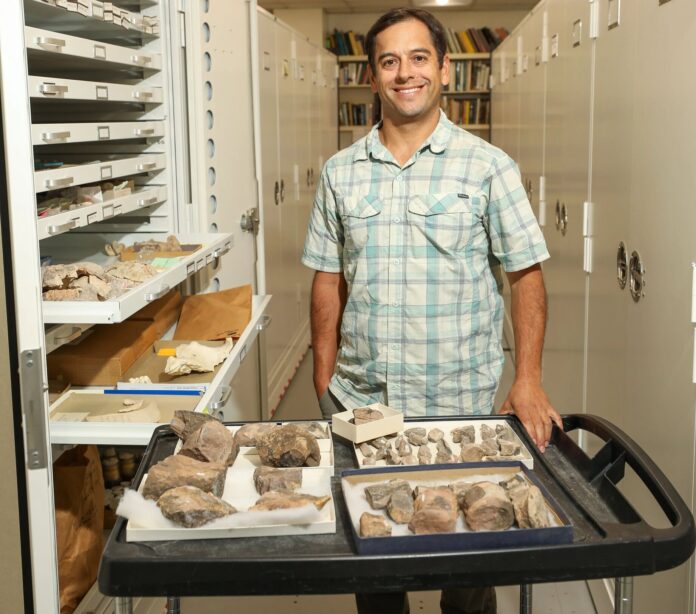A dinosaur fossil discovery by a researcher from The University of Texas at El Paso may expand the known range of a species that roamed Earth approximately 115 million years ago.
Jason W. Ricketts, Ph.D., associate professor in UTEP’s Department of Earth, Environmental and Resource Sciences, discovered the fossils—identified as belonging to the dinosaur Tenontosaurus—while conducting unrelated fieldwork at Indio Mountains Research Station (IMRS), a UTEP-owned natural laboratory that spans more than 41,000 acres in southeastern Hudspeth County, about 26 miles southwest of Van Horn, Texas.
“I wasn’t out looking for fossils that day,” said Ricketts. “I was studying the rocks in the area when I noticed fragments weathering out of soft shale. There was no need to excavate—I simply picked them up. It was an unexpected and exciting find, and my family even came out with me to help collect the pieces.”
Ricketts details the discovery in a paper titled “An Ornithopod Dinosaur from the Lower Cretaceous of West Texas,” which was recently published by the New Mexico Museum of Natural History and Science. Spencer G. Lucas, Ph.D., paleontology curator at the museum, and Sebastian G. Dalman, a doctoral student at Montana State University, coauthored the study.
Dinosaur fossil discoveries in West Texas are rare, and the finding of fossilized bones, rather than just footprints, is especially uncommon, Ricketts said. The fossils were found as individual fragments, with the largest identified as part of a femur leg bone. Although incomplete, the fossils have significant scientific value, he said. Before this discovery, the nearest places where similar fossils had been found were Montana, Idaho, Arizona, and other parts of Texas.
“This discovery extends the known range of Tenontosaurus farther southwest than previously documented,” Ricketts explained. “Until now, fossils of this species were known primarily from localities farther north and east, such as Utah and Wyoming. This finding shows that Tenontosaurus lived as far south as West Texas.”
Tenontosaurus was a medium-sized, plant-eating dinosaur that lived during the Early Cretaceous period. The discovery site adds an important piece to the puzzle of how these dinosaurs dispersed across North America and adapted to diverse environments, the team said.
Liz Walsh, Ph.D., interim dean of the UTEP College of Science, praised the discovery as an example of how curiosity-driven research can lead to major insights.
“This find highlights the importance of fieldwork and the role of dedicated researchers like Dr. Ricketts in uncovering new chapters of Earth’s history,” Walsh said. “It’s also a reminder that major discoveries can happen when we least expect them.”
While the fossil fragments are still being studied, Ricketts hopes the discovery will inspire further exploration in West Texas, a region that remains largely underexplored for dinosaur fossils.
“This discovery shows that there’s still much to learn about our region’s prehistoric past,” he said. “It’s a privilege to contribute even a small piece to that bigger story.”
More information:
Spencer G. Lucas et al, An Ornithopod Dinosaur from the Lower Cretaceous of West Texas (2025)
Provided by
University of Texas at El Paso
Citation:
Dinosaur discovery extends known range of ancient species (2025, November 4)
retrieved 4 November 2025
from https://phys.org/news/2025-11-dinosaur-discovery-range-ancient-species.html
This document is subject to copyright. Apart from any fair dealing for the purpose of private study or research, no
part may be reproduced without the written permission. The content is provided for information purposes only.



